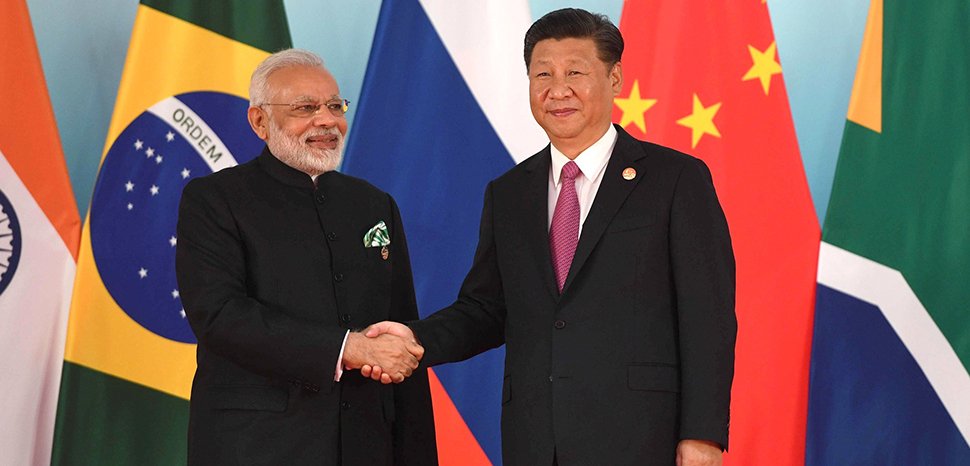
Recent Developments
- Diplomatic Engagements: Recent high-level talks between India and China, including meetings between foreign ministers, aim to ease tensions and address border disputes.
- Military Talks: Ongoing military discussions under established protocols have focused on disengagement in sensitive areas along the Line of Actual Control (LAC).
- Indian External Affairs Minister emphasised that peace along the LAC is vital for stable bilateral relations and highlighted that dialogue is crucial for resolving outstanding issues.
- G20 and BRICS Participation: Both nations participated in the G20 summit and BRICS meetings, showcasing efforts to engage on global platforms despite bilateral tensions.
- Economic Partnerships: India is exploring opportunities to diversify economic ties and reduce reliance on Chinese imports, focusing on self-reliance initiatives.
Historical Ties
- Ancient Contacts: Written records of contact between India and China date back to at least the 2nd century B.C., marking a long history of cultural exchange.
- Silk Road: The Silk Road was a crucial trade route that facilitated economic and cultural exchanges, with Buddhism spreading from India to East Asia along these paths.
- Fa Xian’s Visit: In AD 402, Chinese monk Fa Xian visited India, stayed for a decade, and translated many Sanskrit Buddhist texts into Chinese, enriching both cultures.
- Bodhidharma’s Influence: In the 5th century AD, Bodhidharma, a South Indian monk, became the first patriarch of the Shaolin Monastery in China, influencing Chinese martial arts and philosophy.
- Xuan Zang’s Journey: Xuan Zang (Hiuen Tsang) travelled to India during Harsha Vardhana’s reign in the 7th century AD to acquire Buddhist scriptures, strengthening the cultural ties.
Significance of India-China Relations
- Geopolitical Neighbour: China shares a 3,488 km border with India, affecting regional stability.
- Balancing Power: India views China as a balancing force, prompting it to enhance its capabilities and forge strategic alliances.
- Economic Relations: China is India’s second-largest trading partner, making bilateral trade and investment crucial for mutual growth.
- Border Disputes: Ongoing border issues generate tensions, necessitating effective regional peace and stability management.
- Indian Ocean Dynamics: China’s naval expansion poses significant challenges to India’s traditional dominance in the Indian Ocean region as it seeks to establish a stronger maritime presence.
Challenges
- Territorial Disputes: Ongoing conflicts over borders in the South China Sea and the Himalayas create persistent tension and distrust.
- Debt Trap Diplomacy: China’s strategy of extending loans to developing nations leads to economic dependence, potentially compromising their sovereignty.
- Five Fingers of Tibet: China’s strategy aims to influence five regions surrounding Tibet—Ladakh, Nepal, Sikkim, Bhutan, and Arunachal Pradesh—threatening India’s territorial integrity and regional security.
- Strategic Encirclement: The “String of Pearls” initiative increases China’s military presence in the Indian Ocean, posing direct challenges to India’s maritime security.
- China’s Salami Slicing Strategy: In military terms, Salami Slicing refers to a divide-and-conquer strategy involving incremental threats and alliances to overcome opposition and acquire new territories.
- Water Security: China’s control over major rivers like the Brahmaputra threatens India’s water security, requiring careful management.
- Cybersecurity Challenges: India faces significant cybersecurity threats from China, emphasizing the need for robust defences.
- Trade Imbalance: India’s substantial trade deficit with China, especially in Active Pharmaceutical Ingredients, highlights the need for fair trade practices.
India’s Response
- Global Alliances: India is forming strategic partnerships with like-minded nations, including QUAD (with the US, Australia, and Japan) and I2U2 (with Israel, the USA, and the UAE) to counter China’s influence.
- India-Middle East-Europe Economic Corridor (IMEC): This corridor aims to enhance trade connectivity and strengthen India’s presence in the Arabian Sea and the Middle East, countering BRI.
- International North-South Transport Corridor (INSTC): This multi-modal transport network connects India with the Persian Gulf and Caspian Sea, providing a strategic alternative to the China-Pakistan Economic Corridor (CPEC) and monitoring China’s activities.
- Indian Ocean Rim Association (IORA): Engaging in economic cooperation and sustainable development initiatives among Indian Ocean nations to strengthen regional ties.
- Necklace of Diamonds Strategy: A counter-strategy to China’s String of Pearls, focusing on enhancing naval presence, expanding military bases, and strengthening diplomatic relations with regional nations.
- Vibrant Villages Programme: An initiative to develop villages along the border to enhance infrastructure and connectivity, thereby improving local economies and security.
Way Forward
- Strengthened Regional Diplomacy: India’s participation in the QUAD dialogue with the U.S., Australia, and Japan exemplifies efforts to foster regional security in the Indo-Pacific.
- Investment in Defence: The increase in defence spending and the acquisition of advanced weaponry, such as the Rafale fighter jets, enhance India’s military capabilities along the borders.
- Strategic Partnerships: Strengthening defence ties with countries like Australia and Japan through military exercises, such as the Malabar Naval Exercise.
- Infrastructure Development: Initiatives like the Bharatmala Project aim to enhance domestic connectivity, bolstering economic resilience against external influences and fostering regional trade links.
- People-to-People Connections: Expanding cultural exchange programs, such as increased scholarships for Indian students in China and vice versa.
- Joint Initiatives in Global Governance: Collaborating on global issues like climate change, public health, and counter-terrorism through platforms like BRICS or the Shanghai Cooperation Organization (SCO).
- Enhanced Diplomatic Dialogue: Establishing regular diplomatic channels and dialogues to address border disputes can prevent misunderstandings. The India-China Strategic Economic Dialogue could be revived to comprehensively discuss economic and strategic issues.
- Cooperative Framework for Border Management can help reduce tensions. E.g. 1993 Agreement on the Maintenance of Peace and Tranquillity along the LAC.
Author: Arjun Kr. Paul
Comments (0)
Categories
Recent posts


Q5/ Section B, APSC Mains 2024 Essay - ...
29 Jul 2024
Satellite Town
21 Jul 2024
Q 1/Section A, APSC Mains 2024 Essay - ...
29 Jul 2024



